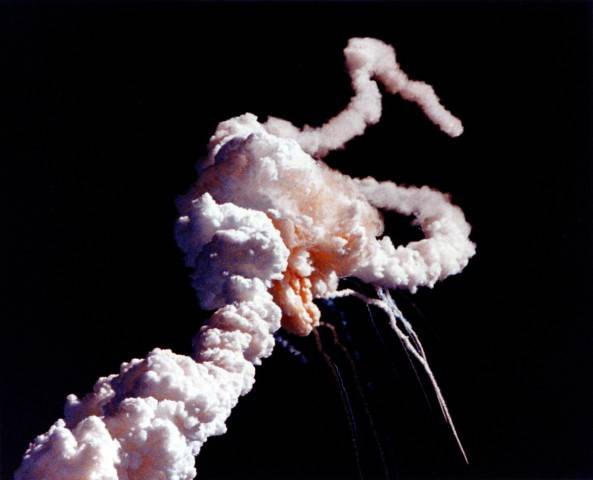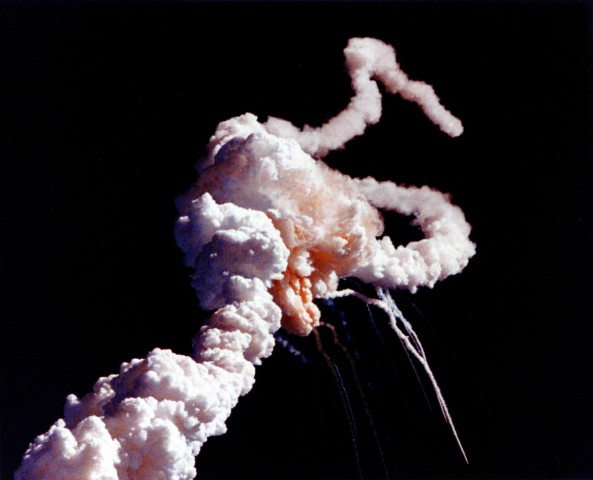
This photograph shows the Challenger space shuttle exploding after seconds after liftoff. The fatal incident occurred in the United States’ space program on January 28, 1986. Space Shuttle Challenger (OV-099) broke apart 73 seconds into its flight, killing all seven crew members aboard. The crew consisted of five NASA astronauts, and two payload specialists. The mission carried the designation STS-51-L and was the tenth flight for the Challenger orbiter.
The spacecraft disintegrated over the Atlantic Ocean, off the coast of Cape Canaveral, Florida. The disintegration of the vehicle began after a joint in its right solid rocket booster failed at liftoff. The failure was caused by the failure of O-ring seals used in the joint that were not designed to handle the unusually cold conditions that existed at this launch. The seals’ failure caused a breach in the rocket booster joint, allowing pressurized burning gas from within the solid rocket motor to reach the outside and impinge upon the adjacent booster. This led to the structural failure of the external tank. Aerodynamic forces broke up the orbiter.

The crew compartment and many other vehicle fragments were eventually recovered from the ocean floor after a lengthy search and recovery operation. The exact timing of the death of the crew is unknown; several crew members are known to have survived the initial breakup of the spacecraft. The shuttle had no escape system and the impact of the crew compartment at terminal velocity with the ocean surface was too violent to be survivable.
The disaster resulted in a 32-month hiatus in the Space Shuttle program and the formation of the Rogers Commission, a special commission appointed by United States President Ronald Reagan to investigate the accident. The Rogers Commission found that NASA’s organizational culture and decision-making processes had been key contributing factors to the accident, with the agency violating its own safety rules. NASA managers had known since 1977 that contractor Morton-Thiokol’s design of the SRBs contained a potentially catastrophic flaw in the O-rings, but they had failed to address this problem properly. NASA managers also disregarded warnings from engineers about the dangers of launching posed by the low temperatures of that morning, and failed to adequately report these technical concerns to their superiors.
Approximately 17 percent of the US population witnessed the launch on live television broadcast because of the presence of high school teacher Christa McAuliffe, who would have been the first teacher in space. Media coverage of the accident was extensive; one study reported that 85 percent of Americans surveyed had heard the news within an hour of the accident. The Challenger disaster has been used as a case study in many discussions of engineering safety and workplace ethics.

The spacecraft disintegrated over the Atlantic Ocean, off the coast of Cape Canaveral, Florida. The disintegration of the vehicle began after a joint in its right solid rocket booster failed at liftoff. The failure was caused by the failure of O-ring seals used in the joint that were not designed to handle the unusually cold conditions that existed at this launch. The seals’ failure caused a breach in the rocket booster joint, allowing pressurized burning gas from within the solid rocket motor to reach the outside and impinge upon the adjacent booster. This led to the structural failure of the external tank. Aerodynamic forces broke up the orbiter.

The crew compartment and many other vehicle fragments were eventually recovered from the ocean floor after a lengthy search and recovery operation. The exact timing of the death of the crew is unknown; several crew members are known to have survived the initial breakup of the spacecraft. The shuttle had no escape system and the impact of the crew compartment at terminal velocity with the ocean surface was too violent to be survivable.
The disaster resulted in a 32-month hiatus in the Space Shuttle program and the formation of the Rogers Commission, a special commission appointed by United States President Ronald Reagan to investigate the accident. The Rogers Commission found that NASA’s organizational culture and decision-making processes had been key contributing factors to the accident, with the agency violating its own safety rules. NASA managers had known since 1977 that contractor Morton-Thiokol’s design of the SRBs contained a potentially catastrophic flaw in the O-rings, but they had failed to address this problem properly. NASA managers also disregarded warnings from engineers about the dangers of launching posed by the low temperatures of that morning, and failed to adequately report these technical concerns to their superiors.
Approximately 17 percent of the US population witnessed the launch on live television broadcast because of the presence of high school teacher Christa McAuliffe, who would have been the first teacher in space. Media coverage of the accident was extensive; one study reported that 85 percent of Americans surveyed had heard the news within an hour of the accident. The Challenger disaster has been used as a case study in many discussions of engineering safety and workplace ethics.


